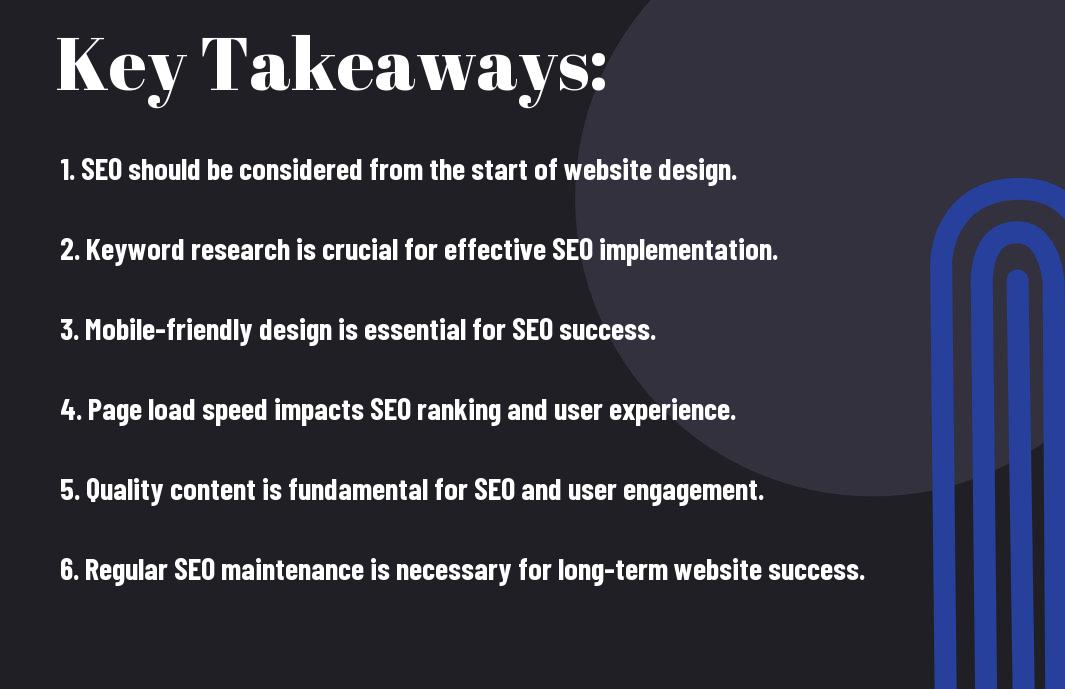In today’s digital landscape, it is imperative that you prioritize search engine optimization (SEO) in every aspect of your web design and development process. Neglecting the integration of SEO from the outset can result in your website being virtually invisible to potential visitors, hindering your online success. From your site’s structure to its content and performance, implementing SEO best practices from the beginning ensures that you build a strong foundation for your online presence. By incorporating SEO into every step of your web design and development process, you can enhance your website’s visibility, drive organic traffic, and ultimately, achieve your digital goals.
Key Takeaways:
- SEO is essential in every step of web design and development to ensure that the website is visible and ranks well in search engine results.
- Integrating SEO into the design and development process from the beginning can lead to long-term success and better overall performance.
- Keyword research and optimization should be prioritized to attract the right target audience and improve the website’s visibility.
- Creating SEO-friendly URL structures and optimizing website loading speeds are crucial technical aspects of web design and development.
- Continuous SEO monitoring and adjustments are necessary to stay ahead of algorithm updates and maintain high search rankings once the website is live.

SEO Fundamentals in Web Planning
While planning your website, it’s crucial to consider SEO from the very beginning. By integrating SEO into the web planning process, you can ensure that your website is built with a solid foundation for search engine visibility. This will ultimately help your site rank higher in search engine results, driving more organic traffic to your site.
Keyword Research and Strategy
When it comes to SEO, keyword research is the cornerstone of your strategy. It’s important to identify the keywords and phrases that your target audience is using to search for the products or services you offer. By understanding the keywords your audience is using, you can tailor your content to be relevant and useful for them. You should also consider the level of competition for each keyword and prioritize those that have high search volume but low competition. This will allow you to optimize your content for the keywords that will give you the best chance of ranking well in search results.
Structuring Your Site for SEO
When structuring your website, it’s essential to prioritize user experience and SEO. Creating a clear and organized site structure not only helps your visitors navigate your site more easily but also makes it easier for search engines to crawl and index your pages. By organizing your site logically and using proper headings, titles, and meta descriptions, you can make it easier for search engines to understand the purpose and content of each page, ultimately improving your chances of ranking well.
Designing with SEO in Mind
Keep in mind that the way you design your website can have a significant impact on its search engine optimization. When you start the design process, it’s crucial to consider how each decision you make will affect your site’s visibility in search engine results. By incorporating SEO best practices into your design process, you can ensure that your website is not only visually appealing but also well-positioned to rank highly in search engine results.
Mobile-First Design and User Experience
When designing your website, you should prioritize the mobile experience. Mobile optimization is essential for SEO, as search engines like Google now prioritize mobile-friendly websites in their rankings. By adopting a mobile-first approach to your design, you can ensure that your website provides a seamless and engaging experience for users across all devices. This not only improves your SEO but also enhances the overall user experience, leading to higher engagement and conversion rates.
Optimizing Visual Elements for SEO
Visual elements, such as images and videos, play a crucial role in web design, but they also offer valuable opportunities for SEO optimization. When adding visuals to your website, you should optimize them for search engines by using descriptive file names, alt tags, and captions. This not only improves the accessibility of your website for users with disabilities but also provides search engines with valuable information about the content of your visual elements. By optimizing your visuals, you can improve your site’s visibility in search results and enhance the overall user experience.
SEO during the Development Stage
After you have conducted keyword research and outlined your SEO strategy, it’s important to consider SEO during the development stage of your website. This ensures that your website is not only visually appealing and functional, but also optimized for search engines. By integrating SEO best practices into the development process, you can set your website up for success from the very beginning. For more information on the importance of SEO in web design and development, check out this blog post on The importance of SEO in web design and development.
Clean and Efficient Coding Practices
When it comes to coding your website, clean and efficient practices are crucial for SEO. Optimizing your code by minimizing unnecessary elements, using clean and semantic HTML, and reducing page load times can positively impact your site’s SEO. Additionally, well-structured code can make it easier for search engine crawlers to index your site, leading to better rankings in search results. By focusing on clean and efficient coding practices, you can lay a solid foundation for your website’s SEO success.
Integrating On-Page SEO Elements
During the development stage, it’s important to ensure that on-page SEO elements are properly integrated into your website. This includes optimizing title tags, meta descriptions, heading tags, and image alt attributes. By strategically placing relevant keywords in these elements and ensuring they accurately reflect the content of each page, you can improve your site’s visibility in search results. Additionally, creating search engine-friendly URLs and implementing structured data markup can further enhance your website’s on-page optimization. Integrating these on-page SEO elements during the development stage sets the stage for a strong SEO foundation.
Post-Launch Strategies
Not only is it crucial to implement SEO best practices during the web design and development process, but it’s also essential to continue optimizing your website post-launch. This ongoing effort will help you maintain a strong online presence and stay ahead of your competition. To learn more about the importance of SEO in web design, check out this comprehensive guide on SEO Process in Web Design: Why It Matters & How to Approach It.
Monitoring SEO Performance
After your website is live, it’s crucial to monitor its SEO performance regularly. You should keep an eye on key metrics such as organic traffic, keyword rankings, and conversion rates. This will help you identify any issues and make necessary adjustments to your SEO strategy. By closely monitoring your website’s SEO performance, you can react quickly to any negative trends and capitalize on positive ones, ultimately improving your online visibility and driving more organic traffic to your site.
Updating Content and SEO Practices
Another important post-launch strategy is to continually update your website’s content and SEO practices. This includes regularly publishing fresh, high-quality content, optimizing meta tags and descriptions, and adapting to changes in search engine algorithms. By updating your content and SEO practices, you’ll keep your website relevant and engaging for both users and search engines, leading to higher rankings and increased organic traffic.

Conclusion: The Importance of SEO in Every Step of Web Design and Development Process
So, as you’ve learned, incorporating SEO into every step of web design and development is crucial for the success of your website. From keyword research to content creation and technical optimization, SEO should be a primary consideration in order to maximize your website’s visibility and reach. By ensuring that your website is SEO-friendly from the beginning, you will set the foundation for long-term success and organic growth. Remember, a well-optimized website not only benefits your search engine rankings, but also enhances the user experience, ultimately driving more traffic and conversions. It’s clear that integrating SEO into your web design and development process is not just important, but essential for achieving online success.
FAQ: The Importance of SEO in Every Step of Web Design and Development Process
Q: What is the importance of SEO in web design and development?
A: SEO is crucial in web design and development as it ensures that your website is visible to search engines and can attract organic traffic. By optimizing your website for search engines, you can improve your online presence and reach your target audience effectively.
Q: How does SEO impact the web design process?
A: SEO significantly impacts web design by influencing the structure, layout, and content of the website. It involves incorporating relevant keywords, creating a user-friendly navigation, and ensuring mobile responsiveness to enhance the overall user experience and search engine rankings.
Q: What role does SEO play in the development process of a website?
A: In the development process, SEO involves optimizing website speed, implementing schema markup, and ensuring proper website architecture. Additionally, it includes resolving technical issues, such as broken links or crawl errors, to ensure the website is easily accessible and indexable by search engines.
Q: Can SEO be integrated after the web design and development process is complete?
A: While it is possible to implement SEO after the website is designed and developed, it is more effective to integrate SEO throughout the entire process. By incorporating SEO from the beginning, you can create a strong foundation for your website that is optimized for search engines and user experience.
Q: What are the potential consequences of neglecting SEO in web design and development?
A: Neglecting SEO in web design and development can result in poor search engine rankings, low visibility, and decreased organic traffic. Without proper SEO considerations, the website may struggle to compete with other sites and fail to reach its intended audience, ultimately impacting the overall success of the website.
